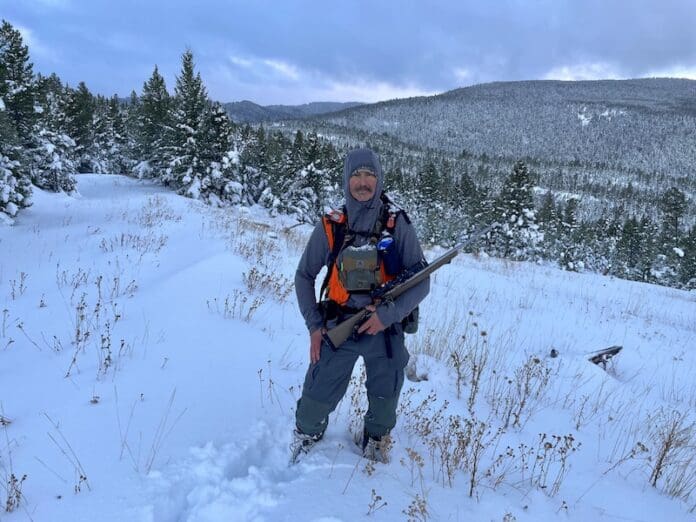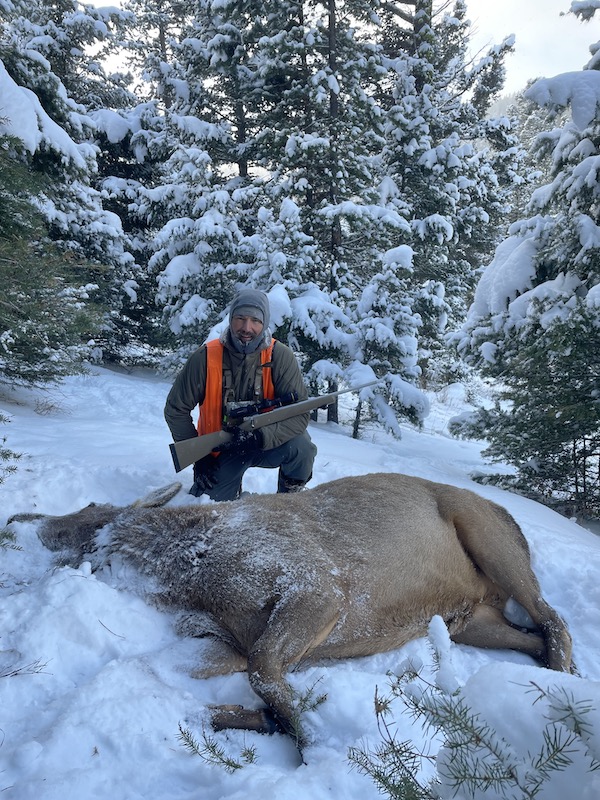The fellas at Rokslide provided me with four different mid-layer jackets to test out; this review will outline my findings. The four jackets are the Outdoor Research Vigor hoodie, the First Lite Origin hoody, the Sitka Ambient hoody, and the Stone Glacier Cirque Lite jacket.
All the jackets fit the description of a mid-layer: a multipurpose layer that can be used on the move in cooler conditions, and in warmer conditions as an insulating piece. You’ll notice all four are hoodies, I simply find a hood indispensable as a means of regulating my body temperature. Some of these pieces are available hoodless if you’re not a hood guy.

Mid-Layer Shootout
A note on the testing, three pieces were worn extensively for two months, from mid-October through mid-December. The last piece, the Cirque Lite wasn’t received until December, but I have worn it extensively since.
I hike daily on local single-track trails, usually 3-5 miles. When I’m not hiking locally, I’m usually hiking in the mountains close by and typically for longer distances. This time frame also included our six-week Montana rifle season. I encountered a wide range of weather: some fairly bluebird weather (lows 40s, highs 60s) to some pretty darn cold conditions (lows 0-10, high 20’s). I didn’t experience a lot of precip but did have the opportunity to wear each piece in wet, snowy conditions.
Looking back over my notes, roughly 500 miles total-each piece getting roughly a fourth of those miles. The terrain varied, as did the snow depth, but nothing was flat. I was averaging close to 200’ of gain/mile and including some very steep climbs- 1000’+/mile.
A note on fit, all four pieces tested are size Large. I’m 5’11’ and ~ 185 lbs- medium build.
Additional Layers Worn
The mid-layers were worn over a lightweight base layer- the Sitka Lightweight hoody. When temps started out in the single digits, I wore the pieces over a heavier base layer- the Patagonia Thermalweight hoody.
Warmth Is Relative
A note on warmth, everyone’s metabolism is different and what is too warm for one person, might be just right for another. Also, the effort exerted obviously changes with ascent, pack weight, snow depth, blowdown, etc, and directly impacts warmth.
When I give temperature ranges, these are based on my direct experience with these pieces (averaging in ever-changing environmental conditions). I do think it will be helpful to provide temperatures, if for no other reason than comparing the pieces used.
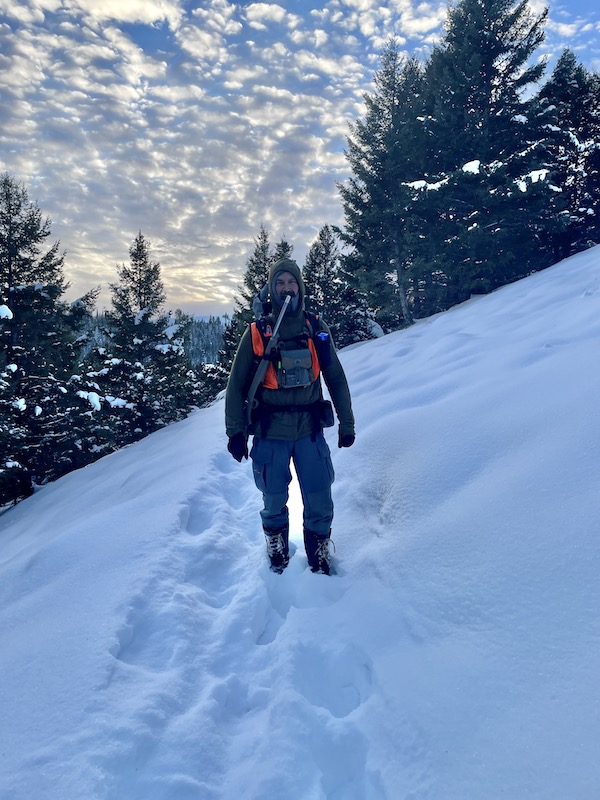
Outdoor Research Vigor Hoodie
The Vigor Hoodie is described as a warm and wicking grid-back fleece crafted with thermo-regulating ActiveTemp™ technology to manage body temperature in quickly changing climates. The Vigor is offered in a couple of different configurations and a few different colors. The one I’m testing is the full zip hoodie in Loden (green)- a nice neutral color suitable for hunting. More Here
Cost, Fabric, and Weight
The Vigor retails for $110, making it the least expensive piece in the test. Fabric is a grid-back fleece (94% polyester, 6% spandex). The grid is relatively open as shown in the photo where you can see light coming through.

Weight is claimed as 12 oz, mine in Large weighed 14.1 oz.
Fit, Features, and Finish
The fit is on the athletic side but is roomy enough to go over a light base layer. The jacket measures 29” in length on the back which is a nice length; it seems too many outdoor jackets anymore are simply too short in the torso—fashion??? The hood fits me very comfortably and snugly; never impinging on my vision. Two side pockets- zipped which is nice, too easy to lose gloves/beanies/snacks/whatever without zippers. An ample-sized chest pocket, but an even nicer (and larger) inner chest pocket.

It comes with thumb holes combined with enough length in the sleeve to aid in hand warmth. This proved to be a nice feature when the mercury dipped.

This piece is a full zip. I like full zips, I’m less of a fan of pullovers as they typically make it tougher to don and take off. A full zip allows for more venting as well.
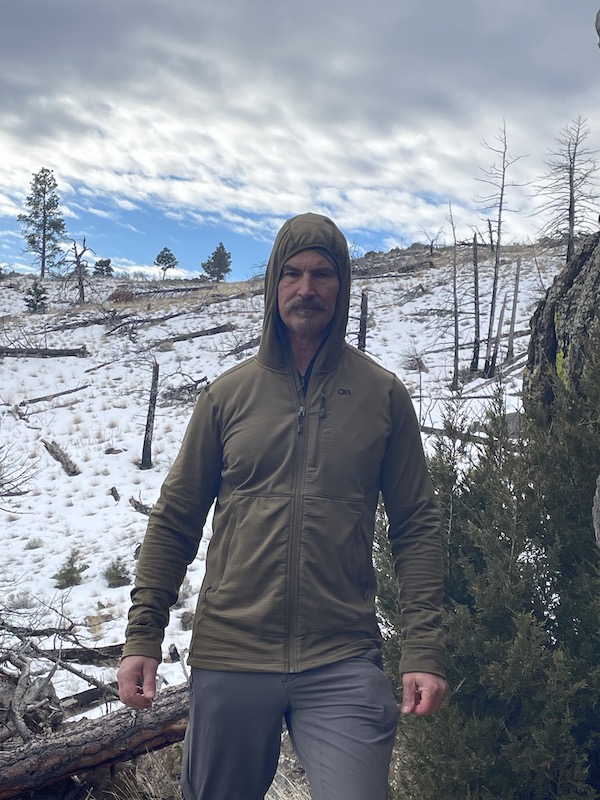
The construction/sewing on the Vigor is what you’d expect out of a top outdoor clothing manufacturer- very good.
Warmth
Mid-layers are expected to provide some warmth while active and static (they aren’t a replacement for a puffy, but can augment one). The Vigor was the least warm of the four jackets tested. Climbing (or moving very quickly,) I’d rate the jacket comfortable to about the mid-teens. Moving more slowly (and less steeply), more like the mid-20s. I tried it in the single digits and just wasn’t warm enough, even climbing I still had to add a wind shirt. It also didn’t fit well over my heavier base layer due to the tighter fit. It did work better in warmer temps, extending its upper-temperature range over the other two jackets- I’d say into the 50s. The approximate temperature range is 25-50.
Quietness
I found the Vigor very quiet moving through thickly forested areas. I’m not an archery hunter, but I think the Vigor would be amply quiet. The Vigor’s fabric was the quietest tested (with the First Lite Origin a very close second). It was slightly more prone to snag, however, which if unnoticed could obviously impact the quietness if a branch is broken in the progress.
Wind and Precip Resistance
The Vigor did not do well with wind, the open grid fabric allowed the wind to come right through. I think this was a trade-off to provide more breathability on the move, which it does. This relates directly to its warmth as well (on the move or stopped); wind simply strips warming ability the more breathable a garment is.
I don’t think anyone expects a fleece garment, especially a more open-weave fabric, to do too well in the precipitation department and the Vigor didn’t. With wet snow, it was wetted out pretty quickly and an outer shell was needed.
First Lite Origin Hoody
Here’s what First Lite has to say about their Origin hoody
“A lightweight, quiet mid-layer designed to be utilized as both an outerwear piece as well as a layering option as temperatures drop.”
The Origin is offered in several solid and camo patterns; the one I’m testing is a half-zip hoody in Ash Grey. More info here.
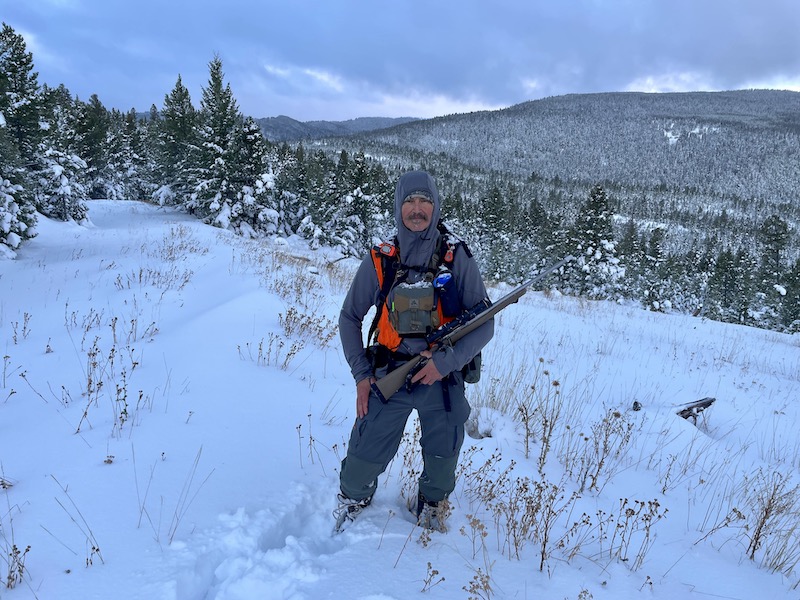
Cost, Fabric, and Weight
The Origin retails for $160. Fabric is a two-layer 37.5 fleece. It has a hard face outer and a more typical fleece inner. The outer fabric also has a DWR coating. Weight is claimed as 15 oz, mine in Large weighed 16.7 oz.

Fit, Features, and Finish
The fit on the Origin is what I say is normal, it’s the roomiest of the four mid-layers tested. It easily fit over a light base layer, but also a heavier base layer when the mercury dropped. The jacket also measures 29” in length on the back which is perfect IMO. The hood is a little roomy for me, but I don’t have a very large noggin either (7 1/8 hat size). Not terrible, but a closer-fitting hood would be better (for me).

It has an integrated face mask that I know that archery hunters would appreciate, but in very cold conditions, even a rifle hunter might appreciate it.
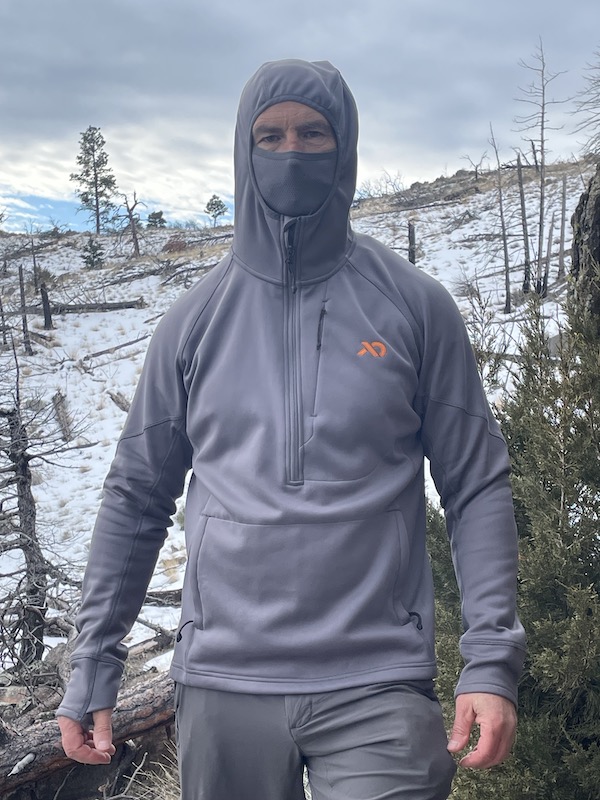
It includes a kangaroo pocket which is nice for warming the hands up. And it’s zipped on both ends- so you won’t be losing anything. An ample-sized chest pocket is also zipped.
It comes with thumb holes that allow for very good hand coverage, which I found really aids hand warmth and allows for a thinner (more dexterous) glove. It’s a half-zip (tough to do a full zip w/ a kangaroo pocket), which is not my preference, but the jacket is cut roomy enough that I had little trouble donning/removing it.
The finish/sewing on the Origin is also top-notch, you can see the attention to detail in the sewing and construction.
Warmth
The Origin is a pretty warm jacket. I think at least part of its warmth is due to the hard-faced outer fabric, which does a pretty good job of keeping the wind out. Climbing (or moving very quickly,) I’d rate the jacket comfortable into the upper single digits. Moving more slowly (and less steeply), more like upper teens. On the other end of the scale, I found it comfortable to about 40 degrees. Approximate temperature range ~ 15-40.
Quietness
The Origin is very quiet, slightly less so than the Vigor. The hard face outer however is less prone to snagging on anything vs the grid fleece of the Vigor, so might well be the quietest adding that in.
Wind and Precip Resistance
The Origin surprised me as it’s the second most wind-resistant jacket of the four tested. I guess that surprised me as fleece isn’t supposed to be wind resistant, but I think the outer hard-faced fabric is what gives it the edge over the other two jackets.
The Origin does have a DWR finish, something not overly common in fleece jackets. The DWR does a decent job in regards to light precip (wet snow in my testing). Again it’s in the context of an active mid-layer, it’s not going to replace most soft shells (and definitely not a hardshell).
Sitka Ambient Hoody
Here’s what Sitka has to say about their Ambient hoody.
“The Ambient Hoody is everything we like in a mid-layer insulation piece — versatile, packable and durable, but adapts to changing weather conditions and levels of activity”
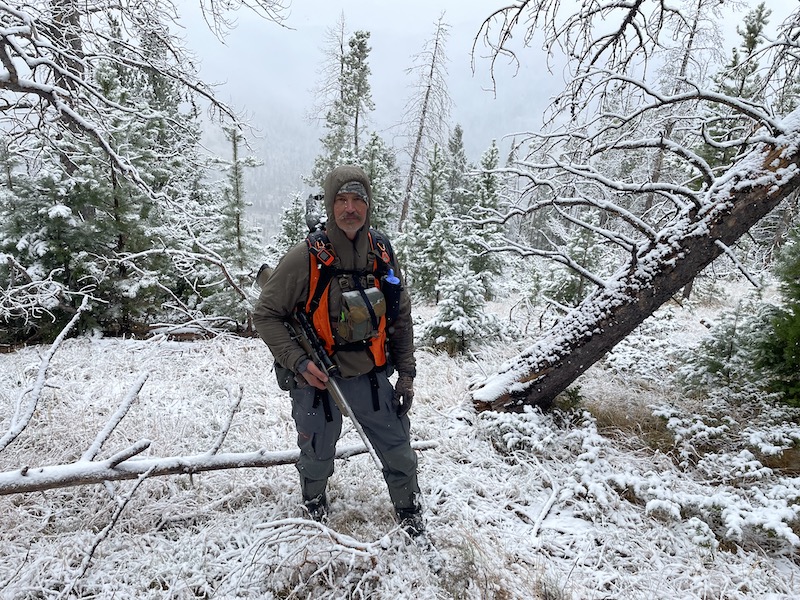
The Ambient is offered in a jacket as well (warmer, but lacks hood) and several camo and solid colors. The one I’m testing is a half-zip hoody in Pyrite. More info here.
Cost, Fabric, and Weight
The Ambient retails for $279, which makes it the most expensive hoody tested. Fabric is 20d nylon outer with a 100-gram Primaloft Evolve. Primaloft Evolve looks a lot like Polartec Alpha Direct—enough so I have a hard time distinguishing the two.

Evolve vs Alpha Direct shown above. (from the MDWi hoody I previously reviewed).
The outer layer has a DWR coating. Weight is claimed as 13 oz, mine in Large weighed 11.9 oz- nice when that happens. It’s the lightest of the mid-layers reviewed.
Fit, Features, and Finish
The fit on the Ambient is somewhat athletic. It does easily fit over a light base layer, but will also fit over a heavier base layer as well. Part of the athletic fit is due to being a half-zip, they are simply harder to don/remove. This hoody measures 29” in length (as do the others).
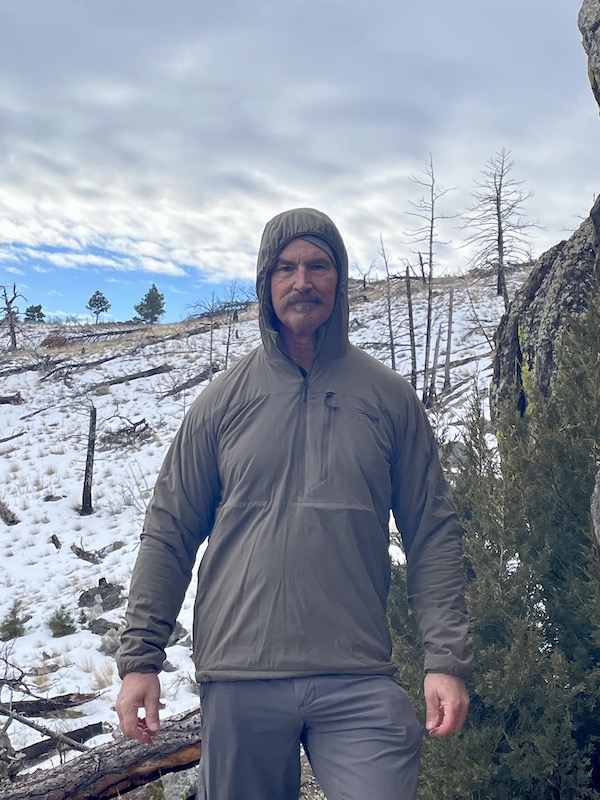
The Ambient has no side pockets, adding a kangaroo pocket would probably not be a bad idea for a pullover. It does have an ample chest pocket (zippered). And it offers an adjustable hem which can come in handy. It does not come with thumb holes, but the elastic at the wrist does a good job of sealing.
The construction/sewing on the Ambient is also top-notch.
Warmth
The Ambient was the second warmest hoody, edging the Origin out slightly, and just under the Cirque Lite. When you look at the picture above of the Evolve fabric, you can see its “fuzzy” appearance which gives it more loft than the two fleece hoodies.
Climbing (or moving very quickly) I’d rate this hoody at single digits. Moving more slowly (and less steep,) I would say 10 degrees. At the upper end, near 50. I felt like the Ambient gave me the widest range of temperatures of all the hoodies tested where it was comfortable. Approximate temperature range 10-50 degrees.
Quietness
The Ambient is quiet but less so than the two fleece entries. It’s tough to beat fleece in that regard. I think it would be quiet enough for archery, but if you’re looking for the very quietest, go fleece.
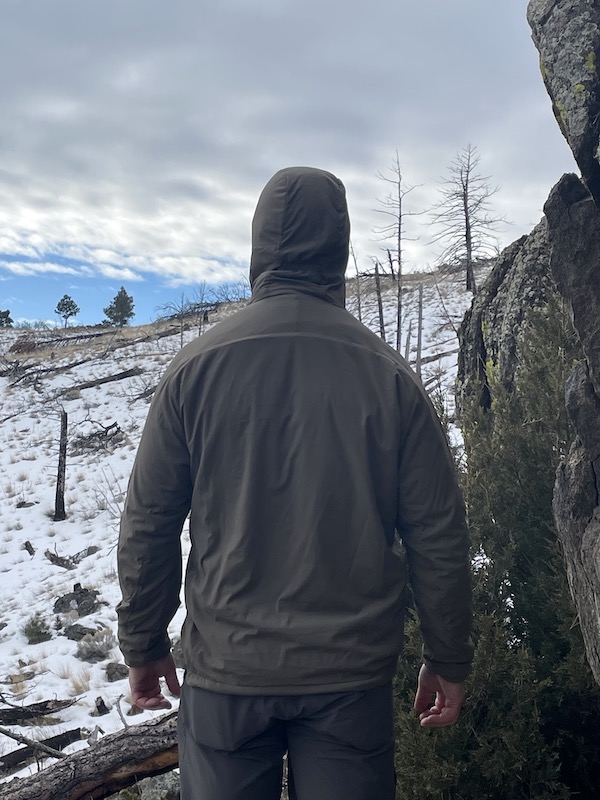
Wind, and Precip Resistance
The Ambient is more wind resistant than the Vigor, but less so than the Origin and Cirque. If it got too windy, I’d put a wind shirt over the top (this was the case for all four jackets).
The Ambient also has a DWR finish. I found it the second most water-resistant of the jackets reviewed. I spent one pretty long day with it spitting wet snow most of it and while the Ambient did show some wetting out here and there, the Evolve fabric was still dry underneath and keeping me warm. Again, none of these active mid-layers are going to outshine jackets made to fight off precipitation.
Stone Glacier Cirque Lite
Here’s what Stone Glacier says about the Cirque Lite
“The Cirque LITE Jacket strikes the perfect balance between warmth, breathability, and weather resistance to create a truly versatile layer that can be worn across the spectrum of mountain hunting conditions.”
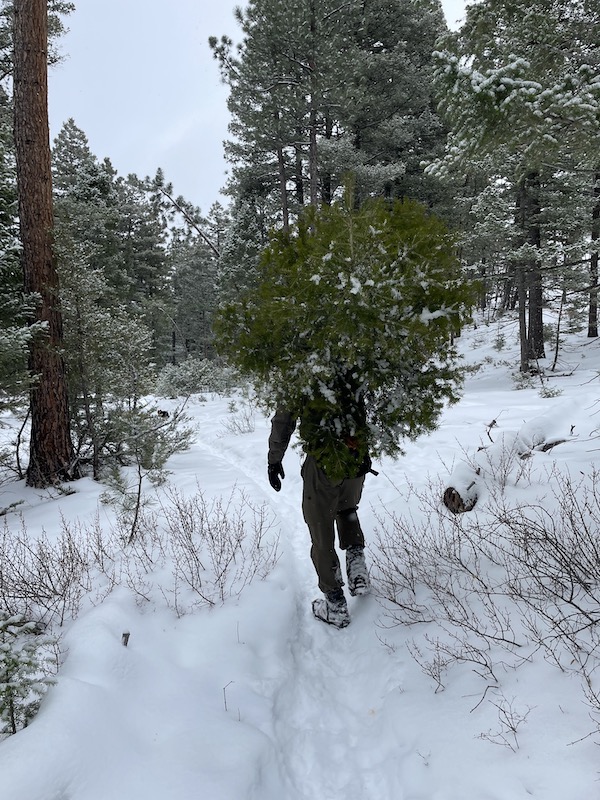
It is also available in a warmer version, the Cirque. The Cirque Lite is available in two muted solid colors, both perfectly suitable for hunting. More info here.
Cost, Fabric, and Weight
The Cirque Light retails for $239, which makes it the second most expensive jacket tested. Fabric is 15d nylon Pertex outer with 60-gram Primaloft Gold insulation. It also has ~ 9” microgrid fleece side panels that extend from the waist to above the armpits. Weight is claimed as 15.2 oz, mine in Large weighed 15.5 oz.
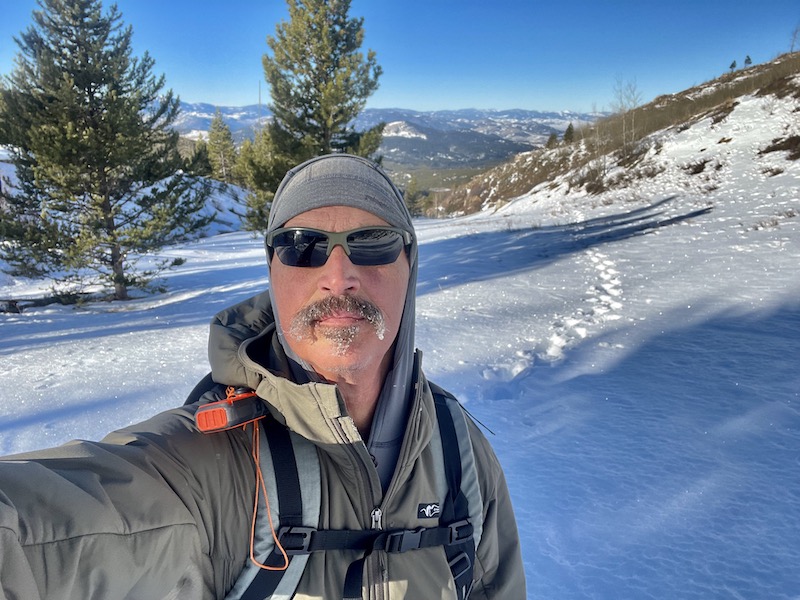
Fit, Features, and Finish
The fit on the Cirque is normal and easily fits over a base layer (light or heavier). The jacket offers a full front zip, my preference for a jacket as it’s easier to don or take off and easier to dump heat. This jacket measures 29” in length (as do the others) which is encouraging to see- simply too many short jackets out there. The hood is great and has a nice adjustment in the rear of the hood to cinch it up.
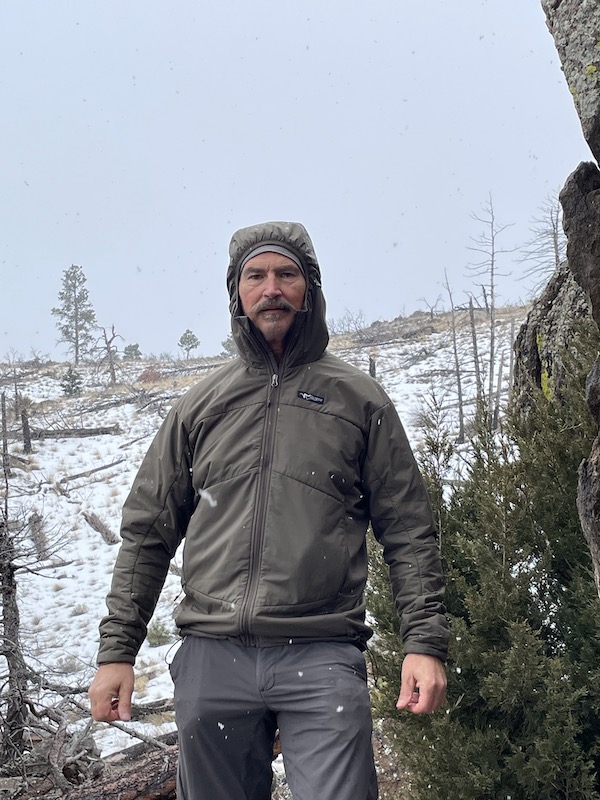
The Cirque Lite has two zippered side pockets. They could be a little deeper in my opinion but are placed a little higher to ease use with a pack on. What it does have that the other jackets don’t are two roomy interior pockets to store stuff out of the weather and closer to the body— this is a feature all jackets should have in my opinion! It has an adjustable hem which I find very useful. It does not come with thumb holes. The sleeves seal tight, but a little too tight for me. Looking at my watch is a bit of a pain having to peel back the sleeve cuff.
The construction/sewing on the Cirque Lite is also top-notch, nice to see that on all four jackets!

Warmth
The Cirque is the warmest of the jackets, just slightly edging out the Ambient. Primaloft Gold is an insulation that has been around for a while, more typical in an insulating layer vs a moving layer. It does do a good job with warmth. Climbing (or moving very quickly) I’d rate the jacket at 0 degrees or even a little lower. Moving more slowly (and less steep) I would say single digits. At the upper end, mid to upper 30’s. Much above the upper 30’s I found the Cirque Lite to be a bit warm. Approximate temperature range 5-35 degrees
Quietness
The Cirque Lite isn’t loud, but the least quiet of the four jackets tested. Peretx is a good weather-resistant fabric, but not the quietest.
Wind, and Precip Resistance
The Cirque is the most wind resistant of the jackets tested. If it got too windy, I’d put a wind shirt over the top (this was the case for all four jackets). Now I want to be clear, it’s the most wind-resistant jacket of the testing, but it’s not going to replace a soft-shell, hard-shell, or most wind shirts in regards to blocking wind.
The Cirque Pertex offered the most water resistance of the jackets reviewed, slightly better than the Ambient. Again, none of these active mid-layers are going to outshine jackets made to fight precipitation.
Wet Base Layer Test
I came up with this test after thinking about a mishap I experienced on a winter backpacking trip last year. I got swept by a creek and was totally soaked up to my neck. Not a good thing in the middle of winter, 30 miles from the nearest trailhead! Anyways I threw on a mid-layer over my soaked base layer and started hiking (pretty fast). Much to my relief approximately three hours down the trail, my base layer was just about totally dry.
So with that in mind, I thought it would be useful to see how these mid-layers did in a similar situation. I fully soaked my base layer, wrung it out a little, and weighed it- 21.6 oz. That’s 15 oz of water (6.6 oz base layer)- not damp, wet! I have a 4-mile loop that starts with a pretty good climb and thought it would be a good candidate. It takes me an hour and fifteen minutes to do the loop at a decent pace. I would also only go out if the weather was the same for each test- near 32 degrees and light wind (hiking with a soaking wet base sucks, colder than freezing would really suck!).
Test Details
I conducted the tests as follows- soak base layer, weigh and insure the base layer weighs 21.6 oz (additional wringing if needed), put in a gallon ziplock and head to the trailhead for the 4 mile loop. Hike the 4 mile loop, put the mid-layer in a dry bag, base layer back in the ziplock, reweigh the base layer and weigh the mid-layer.
This should show me how much moisture was removed from the base layer and what moisture was in the mid-layer (if any). By subtracting the weight of the remaining water in the mid-layer from the water lost in the base layer, it would show the total water removed from the system.
With a little patience, I was able to test all four jackets right at 32 degrees (+/- 1 degree) and with light winds (under 5 mph).
OR Vigor
The Vigor lost 11.2 oz of moisture from the base layer, gaining 2.6 oz of moisture in the mid-layer — a total loss of 8.6 oz. It showed moisture on the outside of the mid-layer almost right from the beginning. The Vigor was the least comfortable during this testing and that might be at least part of the reason. There was visible frost on the forearms (possibly elsewhere I couldn’t see) near the end of the loop.
First Lite Origin
The Origin lost 10.7 oz of moisture from the base layer, gaining 1.2 oz of moisture in the mid-layer— a total loss of 9.5 oz. The Origin showed no moisture on the outside and while not really comfortable, was the most comfortable.
Sitka Ambient
The Ambient lost 10.1 oz of moisture from the base layer, gaining 1.8 oz in the mid-layer— a total loss of 8.3 oz. The Ambient comfort level was a little less than the Origin and Cirque. Part of this might be the better wind protection of the Origin & Cirque over the Ambient because while the winds were light, there are a few places on the loop where you’re more exposed, and a wet base layer lets you feel even light wind.
Stone Glacier Cirque Lite
The Cirque Lite lost 8.6 oz of moisture from the base layer and gained 1.4 oz in the jacket- a total loss of 7.2 oz. The Cirque lost the least amount of moisture, but comfort was on par with the Origin.
While I felt all four did pretty well (they all moved a half pound or more of moisture!), the Origin did the best (moved the most moisture and was still “comfortable”).
“Comfortable” in quotes as I can assure you it wasn’t overly comfortable with a soaking wet base layer in freezing temps! I gave a tie to the Vigor and Cirque Lite because while the Vigor did a better job of moving moisture it was the least comfortable and while the Cirque Lite moved the least moisture, the comfort was on par with the Origin.
I’m pretty confident that with another hour of walking briskly, all four jackets would leave me with a dry (or nearly dry) base layer.
Durability
I didn’t put durability in the chart as I haven’t seen any issues yet with durability with any of the jackets. While I’m confident the fleece offerings will fare better in this regard, I have experienced no holes/tears/rips in the Ambient or Cirque Lite thus far- that’s with several days of tromping through dense timber.
Discussion
I’ve included the chart below with my input on number ranking. Simply adding up numbers won’t reveal the entire picture in my humble opinion. It should contrast the pieces to a certain degree, but I feel the descriptions above and a short discussion would be more enlightening overall.

First, all four pieces are very well made, perform well, and would serve admirably as an active mid-layer. They all fit well (I gave slightly higher marks to the two full zips as that is my preference) and are comfortable.
Outdoor Research Vigor
I think for early season (warmer) or extremely high output activities (x-country skiing/snowshoeing/etc), the Outdoor Research Vigor would be a good piece. Fit is good, full zip and it’s quiet. Fleece is always a good choice in thicker stuff due to its durability. It also happens to be the least expensive of the jackets tested.
First Lite Origin
I’m not an archery hunter, but the First Lite Origin should check a lot of boxes for archers. It’s quiet, it’s warm, fleece is tough in the thick stuff, has a face mask, good hand coverage, and nice hand warmer pockets. The price is also attractive.
Sitka Ambient
I like the Sitka Ambient. It’s warm, comfortable over a wide temperature range, and also pretty weather resistant. It’s the lightest piece, but also the most expensive.
Stone Glacier Cirque Light
The Cirque Light is a neat piece that attempts to bridge the gap between an active layer and an insulating layer. It does a pretty good job in that regard. The Cirque is the warmest jacket and the most weather-resistant piece tested. It doesn’t move moisture quite as well as the others though. I think this would be a very suitable piece for colder weather and also times when you’re looking for one garment to cover a wide range of duties.
Pluses and minuses on each piece, but the bottom line is I’d be happy with any of them.
Comment or ask Mike questions here.
Click here for more clothing reviews.














